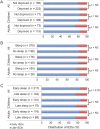Routine vs extended outpatient EEG for the detection of interictal epileptiform discharges
- PMID: 26984946
- PMCID: PMC4836883
- DOI: 10.1212/WNL.0000000000002592
Routine vs extended outpatient EEG for the detection of interictal epileptiform discharges
Abstract
Objective: To compare the yield of epileptiform abnormalities on 30-minute recordings with those greater than 45 minutes.
Methods: We performed a prospective observational cross-sectional study of all outpatient routine EEGs comparing the rate of interictal epileptiform discharges (IEDs) and clinical events during the initial 30 minutes (routine) with those occurring in the remaining 30-60 minutes (extended). A relative increase of 10% was considered clinically significant.
Results: EEGs from 1,803 patients were included; overall EEG duration was 59.4 minutes (SD ±6.5). Of 426 patients with IEDs at any time during the EEG, 81 (19.1%, 95% confidence interval 15.6-23) occurred only after the initial 30 minutes. The rate of late IEDs was not associated with age, indication, IED type, or sleep deprivation. Longer recording times also increased event capture rate by approximately 30%.
Conclusions: The yield of IED and event detection is increased in extended outpatient EEGs compared to 30-minute studies.
© 2016 American Academy of Neurology.
Figures
References
-
- Marsan CA, Zivin LS. Factors related to the occurrence of typical paroxysmal abnormalities in the EEG records of epileptic patients. Epilepsia 1970;11:361–381. - PubMed
-
- Salinsky M, Kanter R, Dasheiff RM. Effectiveness of multiple EEGs in supporting the diagnosis of epilepsy: an operational curve. Epilepsia 1987;28:331–334. - PubMed
-
- Doppelbauer A, Zeitlhofer J, Zifko U, Baumgartner C, Mayr N, Deecke L. Occurrence of epileptiform activity in the routine EEG of epileptic patients. Acta Neurol Scand 1993;87:345–352. - PubMed
-
- Faulkner HJ, Arima H, Mohamed A. Latency to first interictal epileptiform discharge in epilepsy with outpatient ambulatory EEG. Clin Neurophysiol 2012;123:1732–1735. - PubMed
Publication types
MeSH terms
Substances
LinkOut - more resources
Full Text Sources
Other Literature Sources
Medical

